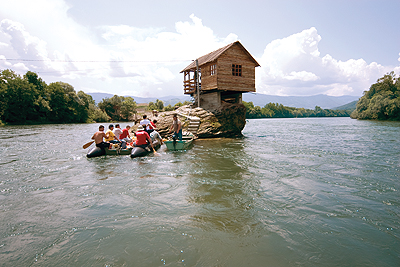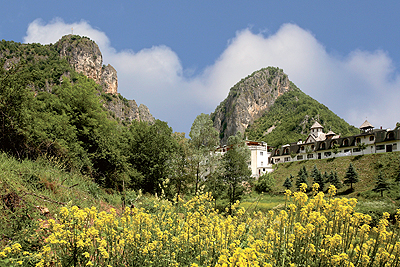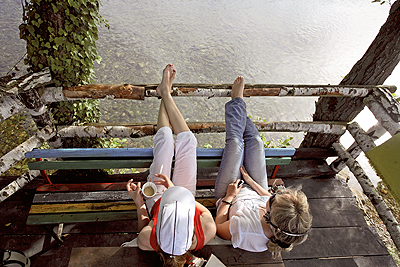Flow
AZBUKOVICA: ETHNO VILLAGE VRHPOLJE AND OTHER STORIES OF DRINA RIVER
People from Wild Waters
Drina River is generous to all those who love it and understand its character. Participants of Drina regattas are such people, which they will confirm this summer, in July, on St. Peter’s Day. Among contents on the beautiful river, which is winding between Serbia and Republic of Srpska, very interesting is the vivid ethno village near Ljubovija, but many more
By: Luka Vesković
Photographs by: Dragan Bosnić
 In the 70s of the 20th century, in the time of industrialization of former Yugoslavia, there were great plans for the complete using of all water currents, especially Drina. One of the planned dams was to flood the lower parts of Azbukovica, including Ljubovija, its administrative center. A part of the population left the fertile soil, but many have seized properties, one by one, so patiently, while waiting for the dam to be built and the command to leave their homes. While they were waiting, there was no building, there was no investing, “who would build anything in a place where everything will be flooded, sooner or later”. In the 70s of the 20th century, in the time of industrialization of former Yugoslavia, there were great plans for the complete using of all water currents, especially Drina. One of the planned dams was to flood the lower parts of Azbukovica, including Ljubovija, its administrative center. A part of the population left the fertile soil, but many have seized properties, one by one, so patiently, while waiting for the dam to be built and the command to leave their homes. While they were waiting, there was no building, there was no investing, “who would build anything in a place where everything will be flooded, sooner or later”.
Luckily, Godot never came to Azbukovica. One of the results of the situation was that Ljubovija was left an undeveloped and poorly populated community. In this unusual twist of fate and forces of history, today it becomes a great advantage of the area. The nature remained intact, the rivers are clear; some people even drink the water from Drina River. After the theory of Nikola Babin, the river which is flowing over rock for nine kilometers cleans out and it is safe to be consumed.
THE RACE UNDER THE STARS
 Nikola Babin is taking some water from the Drina and he is drinking it in front of the National Review reporters. It is not the first time he is drinking the suspicious water. A few years ago, he exchanged his land on a beautiful and popular place for a weedy lot right by the Drina. He cleaned the area himself, he found some old outbuildings, he repaired them and made them into beautiful bungalows. He moved the old house from 1863 from the bank of Mlava and made “Hajdučki raj”. It is also the central building and the reception of Ethno village Vrhpolje. The most beautiful part of “Hajdučki raj” is a spacious terrace above Drina. It is cool during the hottest days. Nikola Babin is taking some water from the Drina and he is drinking it in front of the National Review reporters. It is not the first time he is drinking the suspicious water. A few years ago, he exchanged his land on a beautiful and popular place for a weedy lot right by the Drina. He cleaned the area himself, he found some old outbuildings, he repaired them and made them into beautiful bungalows. He moved the old house from 1863 from the bank of Mlava and made “Hajdučki raj”. It is also the central building and the reception of Ethno village Vrhpolje. The most beautiful part of “Hajdučki raj” is a spacious terrace above Drina. It is cool during the hottest days.
Ethno village in Vrhpolje is only the continuation of the story about “Drinska regata”, which was created by friends of Nikola Babin about ten years ago.
“The regatta became a tradition. It is being organized every second Saturday in July and it gathers about several thousands of participants. The navigation from Rogačica to Ljubovija, 40 kilometers long, is stopping for a while in Vrhpolje”, says Nikola. “In the meantime, the members of the rafting club ’Drinska regata’ have organized ’Regatta under the Stars’, a unique event in Europe. The three-day regatta from Šćepan Polje, the place where Piva and Tara rivers are making Drina, to Ljubovija is the announcement for the beginning of sailing down the Drina. Visitors can organize their own regatta in Vrhpolje, because the ethno village is made especially for the river fans.”
AN EAGLE IN THE TREE
 Besides Drina, Azbukovica has two more interesting rivers. The first one is Trešnjica with its beautiful canyon. Griffon vultures are hatching on the inaccessible cliffs of the canyon, birds that can fly a long distance. Thanks to residents which feed them regularly, the colony of three remaining birds is now counting about thirty. The right tributary of Trešnjica is Tribuća, the river whose canyon can be compared to Nevideo, for its beauty and it (in)accessibility. Besides Drina, Azbukovica has two more interesting rivers. The first one is Trešnjica with its beautiful canyon. Griffon vultures are hatching on the inaccessible cliffs of the canyon, birds that can fly a long distance. Thanks to residents which feed them regularly, the colony of three remaining birds is now counting about thirty. The right tributary of Trešnjica is Tribuća, the river whose canyon can be compared to Nevideo, for its beauty and it (in)accessibility.
The other river is Ljuboviđa. It has its headquarters under Jablanika, taking a part of water from the river basin of Kolubara. “It is a bit into piracy”, say the residents. Then it flows between Bobija and Medvednik, taking a turn near Proslop towards the Drina. Above the river is standing a bridge from the Roman period. The bridge is still in use, even if the former Roman path is not the same as the modern transversals.
Proslop curve is seperating Medvednik from Sokolska Mountain. Together, they create a natural border of Azbukovica and Rađevina. The highest peak of Sokolska Mountain in Rožanj. “It is only about 20 meters away from being one thousand meters high”, say the people of Azbukovica. It has a plateau, of average character, different from the rock on which once was the mighty and the inaccessible Soko Town. According to a legend, the town is the creation of Despotess Jerina, “Irina the Greek woman”, “the greatest Serbian builder of her times”. “My town is secure as an eagle in the tree and no one can conquer it.” History confirmed these words. Soko Town changed its authorities only after serious negotiation.
 The Serbs have not forgotten the Turkish violence in Soko Town. When Prince Mihailo finally got the keys of fortified towns, the people have burned down and destroyed the fortification, one of the most attractive in Europe. Under the rocks of Soko Mountain, a monastery was built in the 90s of the 20th century, dedicated to St. Bishop Nikolaj of Žiča and of Ohrid (Velimirović), with many following objects. This monastery soon became one of the most visited sacred places in Serbia. From the middle of July until the middle of August, on the traditional event “Moba”, descendants of the Serbian emigrants who live on all continents. Moba understands work which includes the whole community, and the job of these children is to learn the language and the customs of their ancestors. The Serbs have not forgotten the Turkish violence in Soko Town. When Prince Mihailo finally got the keys of fortified towns, the people have burned down and destroyed the fortification, one of the most attractive in Europe. Under the rocks of Soko Mountain, a monastery was built in the 90s of the 20th century, dedicated to St. Bishop Nikolaj of Žiča and of Ohrid (Velimirović), with many following objects. This monastery soon became one of the most visited sacred places in Serbia. From the middle of July until the middle of August, on the traditional event “Moba”, descendants of the Serbian emigrants who live on all continents. Moba understands work which includes the whole community, and the job of these children is to learn the language and the customs of their ancestors.
***
Tide
A part of Drina between dams in Bajina Bašta and Zvornik has regular tides. The upper dam releases water in regular intervals, so the level of Drina rises for one half a meter. As the water comes from the bottom of the Lake of Perućac it also refreshes the coastal area. The waterflow is used by boatmen for quicker descents.
***
The Romans
While cleaning the terrain in Vrhpolje a beautiful Roman monument was found which became the trademark of this ethno village. That monument and other remains of the Roman villa, about one hundred meters upstream, indicate that there was a place called Rimski raj on the bank of Drina, before Hajdučki raj. On Nemić Hill, which stands above Vrhpolje, we can still see the remains of the town, which indicate the important presence of Romans in this part of the Drina.
***
Regatta
The event “Drinska regata” is being held since 2002, every second Saturday in July. The route Rogačica-Trešnica-Ljubovija is 40 kilometers long. In 2006, this event included 1080 vessels and more than 10 000 people on water. In 2007, these records were beaten and it is expected even more people in 2008. In the last two years, “Drinska regata” was promoted by the Sports Manager of the Waterpolo Association of Serbia and the famous former selector of the Serbian waterpolo national team, Mr. Nenad Manojlović.
The founder and the main organizer of “Drinska regata” is the association from Ljubovija, whose president Zoran Vojinović, a captain, is also the regatta commander. Detailed information on the web site www.drinskaregata.org.yu.
|
